This is the story of Bruce Rife, a man from Alaska who discovered his dream camper in Denver and ended up in a Hallmark Nepal.

It’s amazing how important the internet is to the truck camper industry and community. Just fifteen years ago, people were lucky to have access to truck campers. Maybe you had a parent, relative, or friend who introduced you to the truck camping lifestyle. Maybe you lived near a truck camper manufacturer or dealership. Perhaps a local RV show featured truck campers and allowed you the opportunity to discover truck campers and the possibilities of the truck camping lifestyle. Lucky you.
In reality, large areas of the United States and Canada, including most of the East Coast, were in truck camper deserts with little to no access to truck campers or truck camper information. The best they could do is catch the rare printed truck camper article or advertisement in a magazine, or pick up a copy of John Steinbeck’s Travels With Charley. Thank you Mr. Steinbeck.
Today the entire truck camper industry and the vibrant truck camping community is at your fingertips via the internet. Whether you’re in Alabama, Alaska, Australia, or Africa, people from all over the world can now discover truck campers and the go anywhere, camp anywhere, tow anything truck camping lifestyle.
This readily available presence has led to interest, demand, and availability in places where truck campers were once as common as the Loch Ness Monster. Truck campers are still a challenge to find for far too many, but through the internet, that’s changing.
The above three paragraphs raced through my mind as I learned about Bruce Rife and his Hallmark Nepal. He was the perfect candidate for a truck camper, but lived in on the Kenai Peninsula in Alaska. Through the internet, he connected with Hallmark RV, and began a journey that has opened up new possibilities of fun and adventure for his family.
As the publishers of Truck Camper Magazine, we are very excited to be part of this story and thrilled that we helped Bruce discover truck camping. This is what TCM is all about. Go Bruce go.
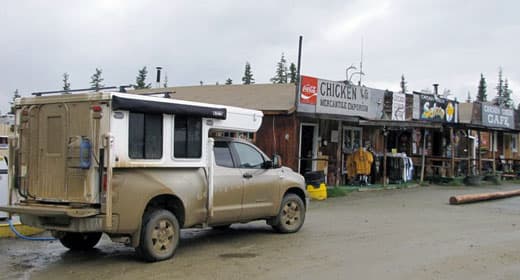
Above: Bruce’s Hallmark Nepal in Chicken, Alaska
TCM: How did you get into truck camping?
Bruce: My wife and I lived in western Colorado for ten years. I was a logger and forester and always had a four wheel drive vehicle. During that time, we were backpackers and camped everywhere. We especially liked Colorado’s high country including Ouray, Silverton, Telluride, and all the national parks nearby.
Sixteen years ago we moved to Alaska. We love it here in Alaska, but it can be very wet and tent camping is not ideal. We bought a Coleman tent camper because we wanted a dry space for the kids and amenities like a heater and sink. I added a 60-watt solar panel which extended the dry camping time of the Coleman, but the tent camper did not allow us to go off-road. We really missed the opportunity of getting off-road.
Now our daughter is at the University of Alaska in Fairbanks and our son is a senior in high school. It was time to start looking for something my wife and I and an occasional kid could enjoy. I wanted to get off-road and back into the slick rock area of Utah and the high country of Colorado as well as travel to some rough roads in Alaska. That’s when we started looking at truck campers.
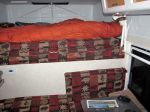 |
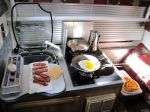 |
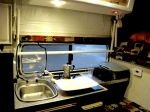 |
TCM: How did you chose the Hallmark Nepal?
Bruce: The Hallmark Nepal was featured in Truck Camper Magazine. From there I noticed Hallmark had a Facebook page and a website showcasing the many possible options available. I had become used to comfort amenities including solar power and I wanted all that.
The Hallmark Nepal is very lightweight and would work with my Tundra. The Nepal also has excellent use of space and features a flush toilet under a seat. We just remove a cushion and it’s there. I was also appreciative that Hallmark had a fiberglass composite roof, that and their four season soft wall fabric is high quality, and the large windows with their bug screens, have been really nice.
Hallmark made the modifications I wanted them to do. They added a hundred watt solar panel and a Yakima roof rack. From a Truck Camper Magazine article I saw that we could put our mountain bikes on the back of the camper. We had Hallmark install the same bike rack so we could hang two bikes on the back of our Nepal.
The heater is wonderful! We chose to not have a hot water heater because we decided it was a waste of space. It’s easier to heat water on the stove for dishes or cooking than to have a permanent hot water tank. Hallmark does offer instant hot water units, but I have not missed having one.
TCM: Why did you get a pop-up camper?
Bruce: A pop-up truck camper is much lighter than a hard side. They are also more aerodynamic when driving and the weight distribution is better. Hallmark puts their water tank front and center. I’ve done enough off-roading to know that you want the weight low and centered.
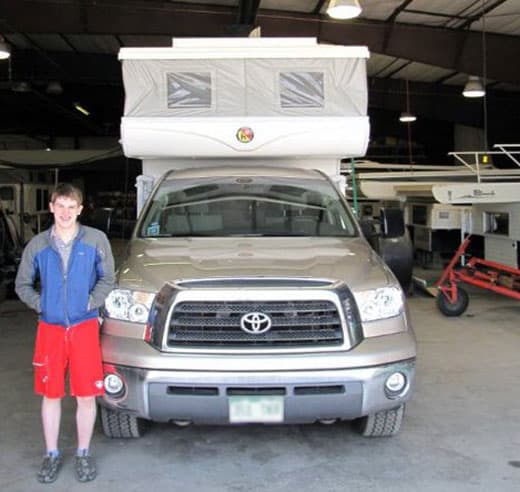
Above: Bruce’s son – picking up the Hallmark Nepal at the Hallmark factory in Fort Lupton, Colorado
TCM: You live in Alaska. You bought a camper in Denver. How did that work?
Bruce: I had seen a handful of Hallmark truck campers wandering in Alaska. When I decided that I wanted more information about Hallmark truck campers, I contacted the company and talked with Matt Ward. They are really friendly at Hallmark. We went back and forth with email and phone conversations talking about features and soon had most of the camper figured out.
The following Spring Break I was hitting the papers in Denver looking for a new truck. The 2007 Tundra had a beefier frame. I got the off-road package. I flew to Denver for Spring break, purchased the Tundra in Denver, drove it to the Hallmark factory, and finally met Matt and the Hallmark team in person.
Matt and I went through the whole camper selection process and picked out all the features I wanted. After we were done and had designed the camper stem to stern, I rented a vehicle for our remaining time in Denver and left the truck at their facility.
As soon as school was out, my son and I flew to Denver. Matt picked us up at the airport and took us to the factory. The truck and camper were ready to go. Matt ran us through the manual and operating procedures. Then we drove out and started our voyage back home to Alaska. That was a year ago, last summer.
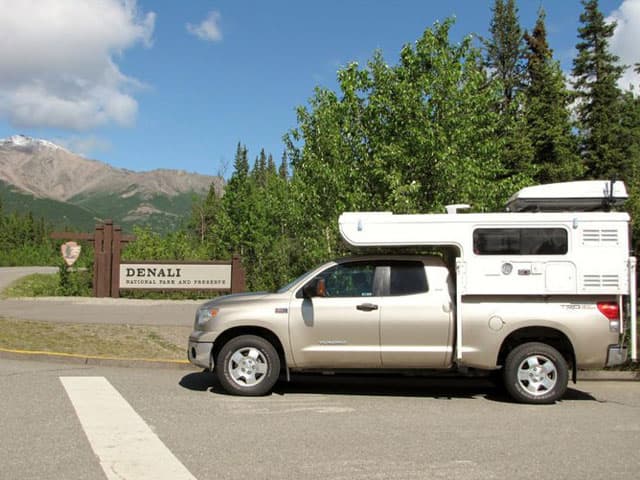
Above: Denali National Park, Alaska
TCM: Are you concerned about animals with a soft top in Alaska?
Bruce: I don’t worry about the animals that much. We use common sense. We put trash in the trash receptacles and lock our food. It would be a motivated bear to get up into our camper.
Savage Campground in Denali does periodically have bear alerts and mandates. They will say that there is no tent camping or tent campers. Even with these warnings, we have felt very comfortable in the Hallmark.
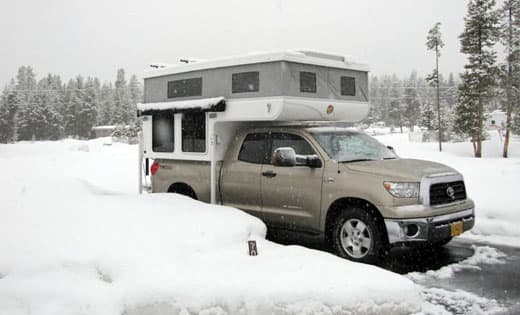
Above: Cold weather has been no problem for Bruce
TCM: What about the cold weather in Alaska? Does the Hallmark keep you warm?
Bruce: Last year my Hallmark, with its insulated soft sides, proved itself in spades. We went through all the national parks and experienced freezing temperatures and snow in Yellowstone. There was three inches of snow on the camper and we were toasty warm inside. People travel the Alcan Highway in the winter, and I fully believe this camper will do it. So far the heater and the insulated fabric have proven themselves.
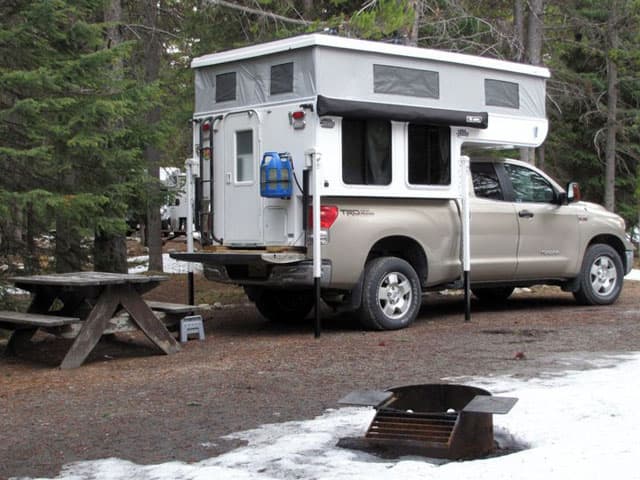
Above: Note the blue propane canister on the back of the Hallmark
TCM: What’s in the blue canister on the back of your rig?
Bruce: The blue canister is a propane container made of translucent fiberglass. If you shake it a little, you can see how much fuel you have left. Everyone who sees it says they’ve got to get one. The fact that you can see the fuel is a real benefit.
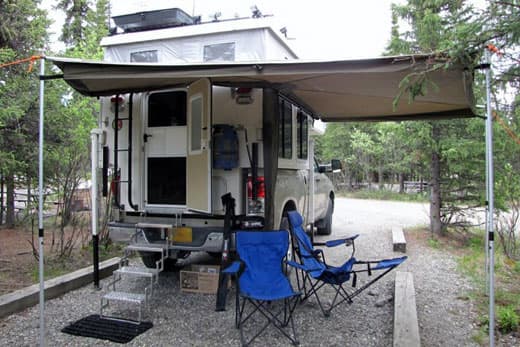
Above: Foxwing Awning set-up while camping
Bruce: I also have the Foxwing awning. It’s been fabulous and literally doubles your living space. The fiberglass propane tank and Foxwing are just two examples of how Hallmark stays on the leading edge of innovative products.
TCM: Why do you keep the tailgate of your truck on with your camper?
Bruce: The pictures that show the tailgate on the truck are from our drive home to Alaska. Normally we remove the tailgate and it’s not on the truck with the camper.
Eventually I want to get a motorsailer boat. I’m moving to Homer, Alaska, which is right on the ocean. I don’t want anything to interfere with towing. The Nepal sticks out about two inches from the tailgate and will be perfect.
TCM: Has your Hallmark Nepal fulfilled your vision for a camper that can accommodate you, your wife, and one of your children?
Bruce: Yes, the camper is perfect for three people. We can lower the dining room table and sleep feet to feet. The Nepal could actually sleep four. It would be nice if we could do that again. If it’s three of us, it’s easy. We even leave the table up.
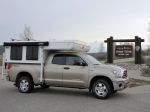 |
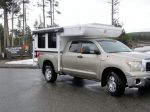 |
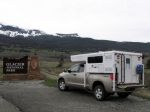 |
TCM: Looks like you took quite the trip from Denver back to Alaska. Tell us about it.
Bruce: The downside of my children growing up in Alaska is they miss the lower 48.
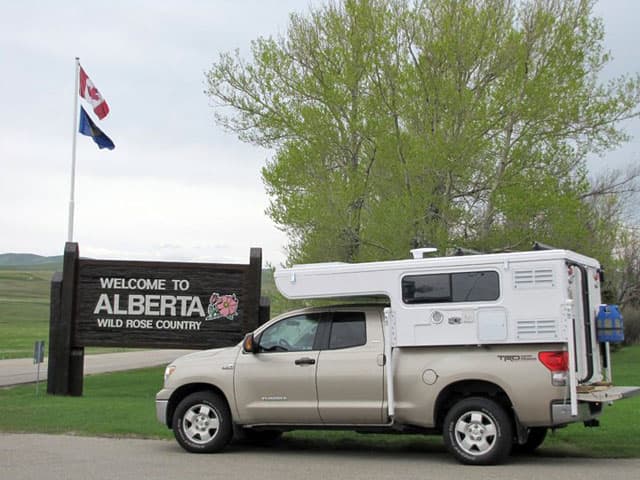
Bruce: On our way back from Denver, my son and I went to Grand Teton National Park, Yellowstone National Park, Glacier National Park, Banff National Park, Waterton Lakes National Park, Jasper National Park, then on to the Alcan Highway to Alaska.
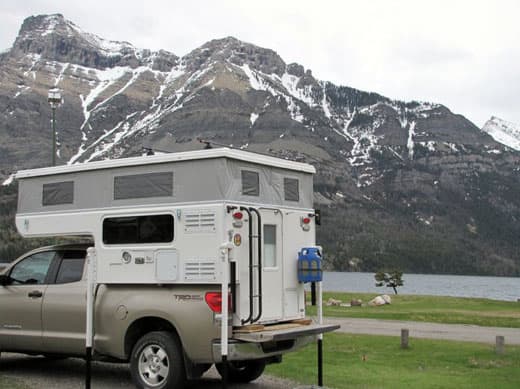
Bruce: We traveled 4,000 miles, and we took three weeks to get back. It was a wonderful trip for the two of us.
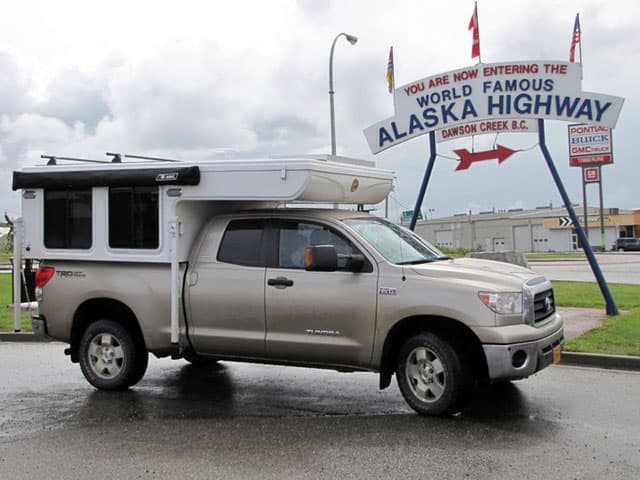
TCM: That sounds like a amazing trip that you and your son will remember for the rest of your lives. How did your Hallmark camper do on the roads going back and into Alaska?
Bruce: We have things called frost heaves here in Alaska. In the winter, ice builds up and the roads elevate as much as a foot. The result is these big rolling bumps on the dirt and asphalt. Some of the newer better highways don’t get frost heaves as much. You have to have pretty good road engineering to take care of it.
There’s a good three to six months of bumpiness up here from these frost heaves. It’s not like a pot hole, they’ll go up maybe six to twelve inches for six to twelve feet. If you’re hitting them at high speeds, you could almost go airborne.
Near the border of Canada and Alaska, all of the roads are subject to frost heaves. I thank Matt every time I drive over them. Between the airbags and the low center of gravity, it handles amazingly well. Last year I took the rig out for the first snow. With the low temperatures and rainy weather, it was fabulous. With the airbags and having only 1500 pounds of camper, it handles our roads and frost heaves amazingly well.
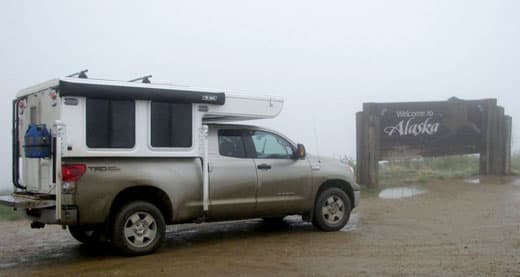
TCM: I can see you hitting a frost heave and bump, “Thank you Matt Ward!” and then another frost heave bump, “Thank you Matt Ward!” That’s funny. Do you have any destination suggestions for truck campers who want to travel to Alaska?
Bruce: I’m partial to the Kenai Peninsula because it’s where I live. Seward has wonderful wildlife tours. There are wonderful boat trips to see the whales and sea lions on the Pacific ocean and the Exit Glacier near Seward is amazing. Homer is Halibut capital of the world, Kachemak Bay State Park is a beautiful state park, You could easily spend a week on the peninsula. There is a wide variety of camping locations for truck campers.
I would recommend at least three days in Denali National Park. Tour the park by bus on two separate days with different drivers and times of the day. When you do that, you quadruple the chances of seeing the bears and other wildlife.
Northwest of Fairbanks is Chena Hot Springs. That is wonderful! Fairbanks also has a fantastic museum. Anchorage has the Alaska Native Heritage Center Museum and the Alaska Museum of Natural History. There are also some really nice state parks in Anchorage in the high country near the city.
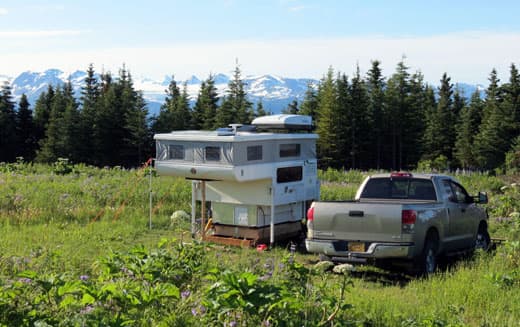
Above: Bruce’s rig at his new house location on the Kenai Peninsula
TCM: You’re using your camper as you build a new house east of Homer, Alaska. How is that working out?
Bruce: I’m living in the Hallmark during the months to monitor and help out with construction of my new home. It’s worked out great to be here on location in my camper. I’ll go home on the weekends to Soldotna, which is about one hundred miles away, to visit with family.
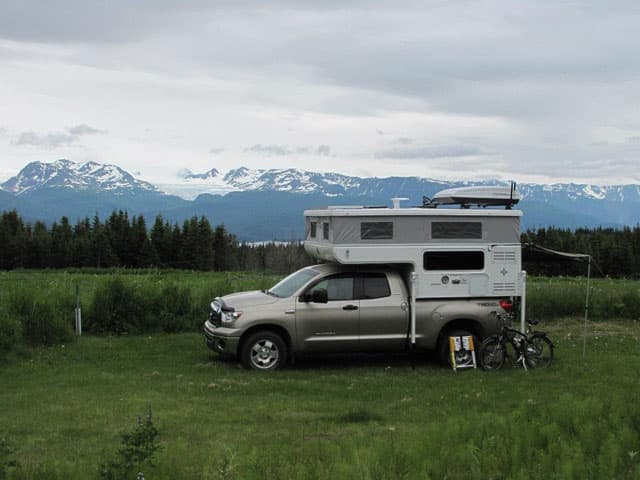
Above: Bruce’s rig at his new house location on the Kenai Peninsula
TCM: Do you have any future trips planned with the Hallmark Nepal?
Bruce: When my wife and I are retired, we’ll go to the desert southwest and lower forty-eight after the holidays in mid-January. In the Fall, they have a drawing for letting the public into Denali. I’d like to do that too.
Both of our kids are going to be in Fairbanks for college. It would be nice to go up there and visit them with the camper. That would be a 600 mile trip from Homer to visit the kids.
As I said earlier, I would like to get a trailerable boat. I could take it to Homer, Seward, and Whittier, which are three major ports around here. We enjoy sailing and recreational fishing. Our main recreation is camping and hiking, followed by kayaking and boating. The nice thing with our set up is that we have the option to tow the boat or ATVs.
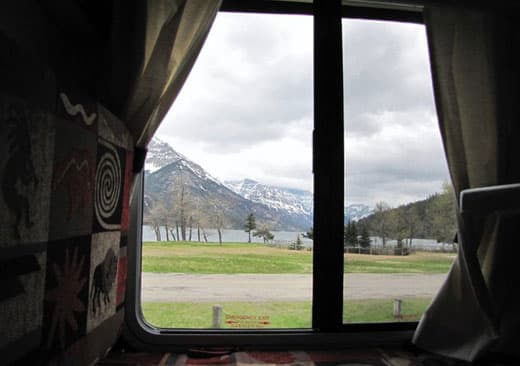
TCM: Anything else that you would like to add?
Bruce: I’m brand new to truck camping. I wanted to comment that it was a lot of the Truck Camper Magazine articles that got me informed. As far as the brand, I just felt that Hallmark was on the leading edge and that I would get a quality product.
| BRUCE RIFE’S TRUCK CAMPER RIG |
| Truck: 2007 Toyota Tundra, extended cab, single rear wheel, standard bed, 4×4, gas |
| Camper: 2011 Hallmark Nepal |
| Tie-downs and Turnbuckles: Happijac |
| Suspension Enhancements: Off-Road adaptation, airbags |
| Gear: Blue propane container, 100w solar panel, Jensen AM/FM DVD player, pop-up television, Jensen antenna, Yakima Rack |
